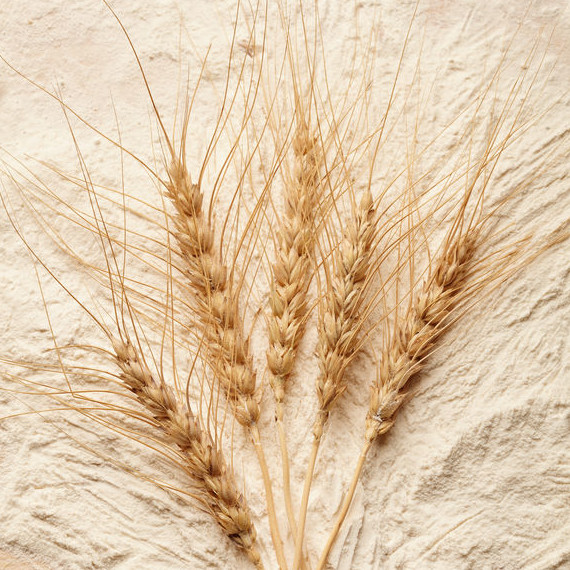Resistant Starch
Also known as Enzyme-resistant Starch
What is Resistant Starch?
Resistant starch (RS) is one type of dietary fiber. It’s defined as the total amount of starch and the products of starch degradation that resist digestion in the small intestine of healthy people.1 In baking, it’s used to improve the nutritional value of baked goods by reducing starch digestibility.
Sources examples are:
- Wheat starch
- Oats
- Raw potato starch
- Legumes
- Green bananas
- High-maize flour
- Retrograded starches
Origin
The term “resistant starch” was first introduced by Englyst et al. in 1982 to describe a small fraction of starch that is resistant to hydrolysis by exhaustive alpha-amylase and pullulanase activity in vitro.2
Four types of resistant starch are known:
- RS1: starch trapped in non-starch polysaccharides
- RS2: crystalline starch in grains, raw potatoes and green bananas
- RS3: retrograded starch
- RS4: chemically- and enzymatically-modified starch
Nutrition and health
Many health benefits are associated with eating resistant starch. By escaping digestion in the small intestine, fermentation of RS in the large intestine produces organic short chain fatty acids (SCFA), which have been shown to be beneficial to colonic health. RS provides important biological effects such as:3
- Improved glycemic index
- Controlled insulin responses
- Gut health
- Reduced blood glucose spikes after a meal
- Production of beneficial short chain fatty acids (SCFA) in the colon
Commercial production
RS1 and RS2 are present in unprocessed and uncooked foods, but RS3 and RS4 can be prepared by selection of appropriate ingredients. Grains with high amylose content are suitable for the preparation of RS3. Here, as the long amylose chains cool down, they adopt a coil structure of retrograded starch which is resistant to enzymatic attack.
Types
The scientific community and regulatory agencies currently recognize 4 forms of RS:1,4
RS1
RS1 is the type of starch that is physically inaccessible to pancreatic amylolytic enzymes and protected to the action of stomach hydrochloric acid due to entrapment by intact cell wall tissues (e.g. cellulose, hemicellulose and lignin). Examples include whole or partially milled cereal grains, coarsely ground seeds and legume kernels.
RS2
It comprises native starch granules protected from digestion by the impervious and highly crystalline structure of the starch granule. RS2 includes native starch, such as high-amylose maize or raw banana starch.
RS3
RS3 encompasses the retrograded starch formed when starch-containing food is cooked then cooled. Examples include cooked and cooled potatoes, stale bread and high-amylose corn starch. Thermal treatments applied during cereal processing (e.g. extrusion, baking, frying) promote the interaction of starch with other components (proteins, lipids, or itself) throughout storage, making it less accessible to enzyme hydrolysis
RS4
RS4 comprises chemically modified or enzymatically cross-linked starches that do not occur naturally but are resistant to digestion.
Application
Bakery products are typically formulated with RS1, RS2 and RS3 starch types to improve their nutritional value by reducing starch digestibility.
The low water-holding capacity of RS helps with crispness and limits dough expansion. RS1 and RS2 can become more available and lose their resistance if the barriers i.e. cell wall tissues are mechanically removed during dry and wet milling or thermal treatment. Cooking or baking can gelatinize these starches to become highly digestible. RS4, on the other hand, can withstand high temperature/pressure processing.
When incorporating RS starches to bread, a general rule of thumb is to never exceed 20% of the flour weight. It is often recommended to add gluten to replace the amount removed during substitution.
Commercial starches with high RS levels may negatively affect volume, grain, crust color and symmetry of bread loaves. Incorporating ascorbic acid and gluten strengthening enzymes, such as transglutaminase, glucose oxidase or xylanase, help in overcoming these challenges.
FDA regulation
According to the latest FDA’s regulatory update, dietary fiber comprise of s:5
- Non-starch polysaccharides and plant cell wall fibers (e.g. β-glucans, arabinoxylans, Cellulose and lignin)
- Resistant starch
- Guar gum, locust bean gum, alginate and pectin
- Psyllium husk
- Galacto- and fructo-oligosaccharides (e.g. inulin and inulin-type fructans)
- High-amylose starch
- Polydextrose
- Resistant starch (resistant maltodextrins and dextrins)
References
- Batey, I., Wrigley, C., and Miskelly, D. “Industrial Processing of Grains Into Co-Products of Protein, Starch, Oils and Fibre.” Cereal Grains: Assessing and Managing Quality, 2nd Edition, Woodhead Publishing, Elsevier Ltd., 2017, pp. 635–651.
- Sajilata, M. G., Singhal, Rekha, S., and Kulkarni, Pushpa, R. Resistant Starch- A Review.Comprehensive Reviews in Food Science and Food Safety. 5 (2006): 1-17.
- Nugent, A. P. Health properties of resistant starch. Nutrition Bulletin. 30 (2005): 27-54.
- Serna-Saldivar. S.O. “Industrial Production of Modified Starches and Syrups.” Cereal Grains Properties, Processing, and Nutritional Attributes, CRC Press, Taylor & Francis Group, LLC, 2010, pp. 402–416.
- U.S. Food and Drug Administration, Questions and Answers on Dietary Fiber, https://www.fda.gov/food/food-labeling-nutrition/questions-and-answers-dietary-fiber, Accessed 22 June 2020.


